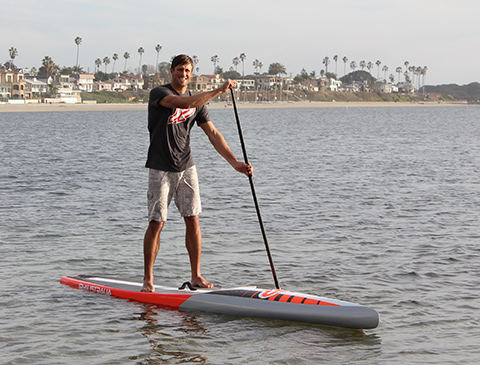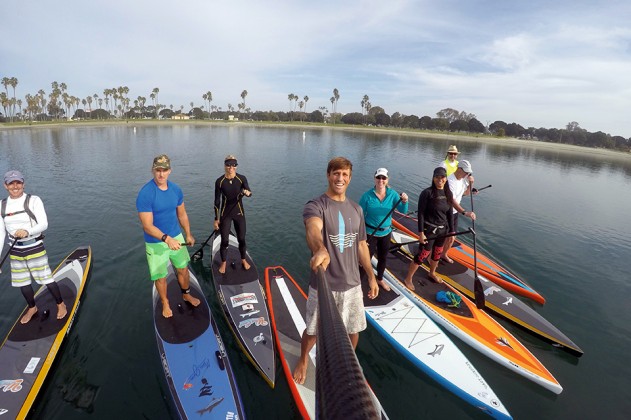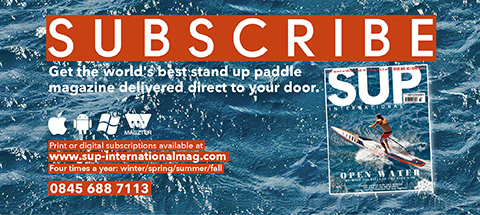PROGRESSION #2 –
BUILD YOUR FITNESS BASE
The beginning of the SUP race season is an important time to put down the foundation of your training. Your training should be planned around your race schedule and paddling goals. Before I get into the first part of your training program I want to talk about one of the most important elements of training, rest.
Rest is as important to your race preparation as mental and physical training. Rest will influence every aspect of your athletic performance including, physical condition, competitive performance, mental toughness and enjoyment in training and racing. In addition to the breaking down of your body through a tough training regimen, the pressure of a long SUP racing season and daily stressors unrelated to paddling will also wear you down. Regular rest helps prevent the accumulated long-term effects of the grind of training and the SUP race season. This is why you will see a minimum of one scheduled day of rest per week in all training programs that I design. The intensity of your training should also be varied to allow for rest depending on the timing of your season, the upcoming race schedule and how you are feeling. This type of training is known as periodization and is described in detail below.
I will provide a lot of information about SUP training, but one of the most important lessons you can learn is to listen to your body. Our bodies are very good at telling us when we need to back off. The most difficult thing is to be aware of these signals and to act on them. Rest is a skill that is learned through repetition and maintaining a thoughtful approach throughout your training and racing schedule. Don’t skip over your rest days!
RESPONSIBLE RACE SELECTION
If you want to improve your placing, times and performance, you need to realize that you can’t do every race and expect to get the results you desire, or to perform at your peak. A common occurrence seen in competitive SUP racing athletes is racing in too many events. An important part of developing an effective training and competition program is to decide what events you want to compete in during the upcoming season.
Your event choices should be based on an assessment of your training program, what your competitive goals are and how you decide to achieve them. Responsible race selection is critical because the SUP racing season can be long and physically demanding. Competing too much can cause illness, injury, fatigue and burnout.
You should only compete when a race meets certain criteria. As a general rule, competitions should serve a specific purpose in fulfilling your seasonal goals. Compete when you need more race experience, when you have the opportunity to race against your peers or to measure your progress. Remember that races should provide positive learning experiences for you that benefit your development. We all like to hang out at the beach with our SUP friends, but we don’t have to race every weekend. If you want to perform at your best and avoid burnout, attend some events as a spectator.
By now you should be starting to think about the goals you want to set. Take a few minutes to write these goals down before continuing to read. Did you do it? Okay, good! Now we can talk about the mind-set you need to have as you begin your training and racing season.
“ Rest will influence every aspect of your athletic performance including, physical condition, competitive performance, mental toughness and enjoyment in training and racing ”
TRAINING INTENSITY
Training at the appropriate intensity is a key element to improving your performance and staying injury free. Harder is not always better. A majority of workouts should be performed at an easy to medium intensity with short intervals of high intensity. Use the information below to help gauge your intensity during your training sessions.
Determining the proper intensity for workouts can be difficult for stand up paddle athletes, especially beginners. Putting a quantifiable number on our level of exertion can properly gauge each workout and ensure we are paddling with the prescribed intensity. Describing a workout as “hard” or “easy” is not sufficient for accurately measuring intensity.
DETERMINING INTENSITY
Intensity can be measured in several ways described below:
Power. Power output is the rate at which energy is used over time and is typically measured in watts. Power output is the most accurate and repeatable measurement for gauging an athlete’s work rate because it is independent of both weather and conditions. Whether it is windy or raining, chop or flatwater, power is power. Generally speaking, the more power you produce, the faster you will be moving on your board. The measurement of power output will potentially provide more accurate training intensity prescription, the ability to objectively test equipment and the ability to accurately apply strategic decision making in races. Unfortunately, there are no consumer-based SUP power measurement devices available yet. However, power (and the means to measure it) has already been seen in both kayaking and rowing research so it is likely that sooner or later it will come to SUP. As a result, it is still important to understand what power is.
Heart rate. Heart rate is our body’s response to the work that we are doing. It not the best method of intensity measurement because heart rate is not always directly correlated to the power being produced. Let’s say you go for a paddle and you feel terrible. Your heart rate is high but your power just is not there. You could be overtrained or getting sick. Therefore, your heart rate will not be an accurate gauge of intensity on this day. Additionally, the heart rates response to exercise can suffer from lag. It takes time to respond to an increase or decrease in effort. By the time the heart rate hits your chosen intensity, the physiological damage may have already been done. Therefore, while it is useful for monitoring your efforts, it isn’t as useful for defining very short duration, high intensity changes in pace. However, until we get accurate power measurement devices for SUP, using a heart rate monitor will be the next best way to ensure training is prescribed at the proper intensity. A heart rate monitor will give immediate feedback about your training effort and minimise any guesswork. Investing in a heart rate monitor to maximize your training efficiency and accurately gauge your effort using the information in this section.
Board speed. Board speed is typically recorded using GPS devices. Board speed by itself is generally an inaccurate measurement for training intensity. We can produce a lot of power/intensity and have a low board speed when paddling into chop, wind or current. The opposite can be true when you have a high board speed but produce a low amount of power/intensity (such as paddling downwind). While heart rate monitors are a more accurate reflection of physical effort, the measurement of board speed increases in value if you paddle in conditions free from wind or current or when repeated intervals are conducted over the same stretch of water in the same direction.
Stroke rate/length. Stroke rate is the number of strokes performed by a paddler per minute. Distance per stroke is the distance taken from when the paddle blade enters the water and is then repeated. In other paddle sports, it has been shown that stroke rate does typically increase as a response to both increases in speed and intensity. However, stroke rate is a faulty measurement for the same reasons as board speed. Stroke length can be affected by either current or wind. We could also produce a low stroke rate paddling into the wind, but the power could be through the roof.

PERIODIZATION
Periodization is a systematic approach to training that allows athletes to increase and decrease their training in order to be in their best condition at a specific time. Broken up into phases, each phase of training can last weeks or months, depending on the individual. Periodization training is the most widely used format of training for endurance athletes and has been tested and proven for decades.
Think of your body as a futuristic adaptable robot (Robo-Paddler!). If you stress one of the systems inside the machine beyond its normal workload, the robot responds to the stress by trying to make that system stronger, strong enough to tolerate the higher stress level. The robot (your body) can, however, only make the system stronger if it is given a rest phase in which to build this stronger system. Training therefore, consists of overloading the body system that is to be trained, letting the system rest and rebuild, and then stressing it again to a higher level. Periodization is all about managing this stress-and-rest cycle to optimize improvement and maximize the overall gain in performance.
Important: The specific volume, intensity and duration of periodization applied to a particular paddler will be strongly influenced by their goals, experience, genetics, age and the race they are training for.
Periodization training plans can be extremely complex and individually designed with multiple peaking periods and hundreds of variables. There is no ‘one size fits all’ approach where one detailed annual plan can give an entire population of athletes successful results. However, the basic annual (macrocycle) periodization phases described can be adapted for use by most athletes with specific changes to fit each individual. All of the Race Ready SUP Training Programs that I design are specific examples of a focused, day-by-day macrocycle, within a periodized annual training plan. You can use the Race Ready Training Programs leading up to a race, but you will still need to decide how to structure the rest of your year. Since it is the beginning of the SUP race season, I would like to talk about the base development phase most paddler should be engaging in now.
BASE DEVELOPMENT PHASE
This phase marks the beginning of your training calendar and should begin with you feeling fully rested from the recovery phase of your off-season. The objective of this phase of training is to gradually return a rested or new paddler to training in a slow, focused routine. New paddlers will need to build their fitness slowly by performing low-intensity, short-duration activities working their way to higher volume. If you are an experienced paddler coming off of a recovery phase, you may have been cross training and need to gradually return to paddling.
Easy, low-intensity paddling that is comfortable and steady is a good way to prepare for the season during this phase. This is a great time to work on technique during slow and focused paddle sessions before intensity is added in future phases. You do not want to launch into an intensive training program that will reinforce bad habits in your technique. Any negative technique qualities can be identified and corrected through a good SUP coach with one-on-one coaching. Focus on paddling slow and working to perfect your technique during this phase. The base development phase can last between 4-20 weeks before beginning the next phase of your training. SUP
BASE DEVELOPMENT FOCUS
• Aerobic conditioning.
• Establish flexibility and institute proper warm-up/cool down strategies.
• Improving cardio and basic muscular strength.
• Cross training.
• Volume of paddling, not intensity. Most workouts should be medium intensity.
• Volume should be gradually increased from week to week.
• Start with around 45 minutes of paddling, working your way up to 90 minute paddle sessions.
• Every 3rd or 4th week should have a volume reduction to allow recovery.
• Correct your technique through slow and focused paddling. Video stroke analysis is recommended during this phase.
• Strength training may be implemented to build muscular strength. Lighter weights with higher reps of 10-12 reps on non-paddling days is recommended. Do not start a strength training program without proper guidance or experience.
• Use bodyweight activities such as pull-ups, push-ups and squats performed with good form.
SAMPLE BASE DEVELOPMENT TRAINING WEEK
Tuesday – 3-mile paddle at easy intensity with focus on perfect technique
Wednesday – Strength training session. 3 x 12 reps of push ups, pull ups, squats
Thursday – 5-mile paddle at medium intensity with random Fartlek intervals (no more than 5-8)
Friday – Cross training/strength session. 50 minute bike ride at medium intensity. 3 x 12 reps of push-ups, pull-ups, squats
Saturday – 6-mile paddle at medium intensity
Sunday – Rest day


